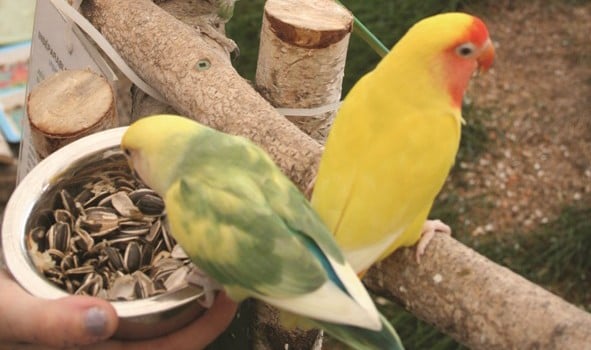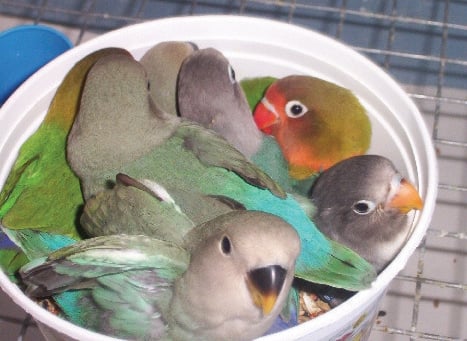
Species Profile Lovebirds
Small, stocky parrots with very short rounded tails. Their beak is very strong despite its size since it is sturdily built more in width than in length. Many years of selective breeding and hybridization has developed a range of colorful mutations. Lovebirds are amazing little parrots; they are funny, spunky, witty and full of spirit. Transposed into a human figure they would be that of an adolescent invading the entire house while playing basketball in your living room, TV blasting MTV, chatting on the phone while emptying the fridge. If you are not to be rebuffed by its piercing and frequent screams, you will find in a lovebird one of the most mischievous intelligent bird. All that in a 50 gram package! They seem to be born to be happy and cheerful. But none the less they too can suffer from neglect, especially if you didn’t take the precaution to raise them to be independent.
Lovebird Facts

- Tribe: Psittaculini
- Species Name: Lovebirds
- Latin Name: Agapornis
- Country of Origin: Mainly Africa and adjacent Islands
- Size: 14-16.5 cms in length
- Weight: 30-50 grams
- Availability in the Pet Market: Extremely popular parrot, widely available & several generations of captive breeding
- Clutch Size: 4-7
- Number of Clutches: 2-3 per year
- Incubation of Eggs: 18-20 days
- Fledging Age in the Wild: 5-6 weeks (feathers fully grown)
- Average (healthy) Weaning Age: 7-10 weeks
- Reproductive Maturity: 1 to 1 1/2 yrs old, reproductively active until 6 yrs. old
- Expected Lifespan: 5-15 yrs (in captivity)
Lovebird Behavior Rating – Scale of 1 to 10 (10 being the highest)
- Personality: Very playful, stubborn and active, tremendous character.
- Sociability: Gregarious by nature; they are exceptionally social if raised interactively. Many people should raise and train at once when young, otherwise they tend to become possessive and bond with only 1 person.
- Easily tamed and gentle: (3 to 9) depending a lot on the individual and the sex
- Family companion bird: (3 to 9) same as aforementioned
- Playfulness: (8 to 10 depending on the species) enjoys swinging, chasing toys, destruction of toys, hiding and are amazingly talented to open cages.
- Biting behavior: Unfortunately quite common with the female although one can easily learn how to recognize the signs and therefore avoiding the biting.
- Physical contact & demonstration for affection: Thrive on being perched on their human companion and some do like to be pet and stroked but usually they get bored quite rapidly. Caution: Avoid always having the bird on you! Let them develop their independence.
- Singing ability: None
- Screaming strength: (4) Frequency: (8)
- Screaming pitch: high pitch scream or chattering
- Talking or mimicking ability: Almost nonexistent. A few learn to say short simple words like hi, hello and “up” but that’s usually the extent of it. Although they can learn to mimic the beep of the micro wave!
- Quality of pronunciation: poor
- Destructive behavior: (2) as its beak is quite sturdy and agile, relative to the species’ small size
- Chewing activity: (7)
- What degree of independence can this species develop: (3 to 9) it depends a lot on the individual, its education, if you are keeping one or two. Should you decide to keep more than one, most probably they will become very independent.
- Eating flingers and messy droppings: (6) if it can be unscrewed, open, thrown, emptied on the floor, and tipped upside down,… it will be! Their droppings are quite normal though, no special messiness there.
- Tendency to engage in feather damaging behavior: Unfortunately mostly females pluck their feathers when building their nest. Although this particular behavior seems more frequent in the Masked and the Peach- Faced. Rarely will we see this behavior in Fisher’s species.
Lovebird Sexual Dimorphism
There is no apparent sexual dimorphism except in the Agapornis pullaria-taranta species1. Some behavioral traits and posture can be indicative for the trained aviculturist. The female Peach-Faced Lovebird (Agapornis roseicollis ) usually carries her nesting material entangled in her rump and lower back feathers. Female Masked Lovebirds carry most of the nesting material in their beaks 1. Most females build elaborately designed nests. Some say that females have a tendency to perch with their legs more open then the male and that consequently their tail appears more rounded than that of the male . The pelvic bones are slightly more distended to allow the passage of the egg, although these observations require a skilled and experienced eye and could be misleading so therefore DNA sexing is strongly advised to confirm sex.
Color Variations in Lovebirds
Over one hundred coloured mutations The first documented mutation in lovebirds was blue Masked Lovebird in 1927. It was captured in Africa and sent to England with green birds. Since then numerous color mutations have appeared in captivity 2

In captivity the most common species are:
- Agapornis Roseicollis (Peach-Faced Lovebird)
- Agapornis Fischeri (Fisher Lovebird)
- Agapornis Personata (Masked Lovebird)
The Masked Lovebird tend to be more aggressive as a companion and as a breeder it is not that rare that the a female kills her mate, and both male and female sometimes kill their chicks.
CAUTION: Do not introduce Masked Lovebirds into a mixed aviary or as a companion to another species of lovebirds.
The Fisher is the least aggressive and is usually less noisy than the other 2. But as a companion it tends to be more shy and needs to be manipulated more than the others, almost every day in its first 2 to 5 months of life, otherwise they will be reluctant to remain tame. As for the Peach-face Lovebird (the most common companion lovebird) he is kind of in the middle; can be slightly aggressive yet it is more sociable then the Fisher.
Notes:
1. Forshaw J.M. ,1989. Parrots Of The World, Lansdowne Editions
2. Wailly, Prin & Prin ,2004. Perruches et Perroquets Atlas de L’ornithologie Vol.1,Animalia Éditions
Lovebird Housing Requirements
- How spacious should the day cage be: A bird cage should be spacious, secure and cleaned frequently. Ideally a minimum of 20 X 20 inches, but larger is better! A play-gym or activity center is also recommended to promote activity and exercise
CAUTION: Spacing of the cage wire must be safe to prevent strangulation. Round bell cages are especially dangerous, as frequent accidents occur at the top where the wire grows narrower.
• Be sure to have a cage with secure latches as lovebirds are famous for their escaping talent.
• Keep bird cage in a safe location, away from dangers such as direct sunlight, kitchen fumes, cold temperature and predators. - Sleeping cage size requirements: Could be as small as 12 X 12 inches. Can also be used as hospital, transport or weekend cage.
- Stimulate activity: Preference for horizontal bars to encourage climbing for all hooked bill species. An open access door to the roof of the cage, access to a play gym and supervised indoor flight is essential for exercise. Secure your homes from any potential dangers before letting your bird fly around freely; always monitor its flight. (eg. Mirrors, open windows, hot stoves cooking pans, water in sink for dishwashing, toilet bowl, ceiling fans).
- What perch sizes should be offered: Minimum 3 sizes of different shapes & texture. Ideally 5/8 inches and 3/4 inches, a manzanita perch type a therapeutic perch and grooming perch.
- Additional in cage: Swings, toys, ladders and bells, twigs, paper towel rolls & other safe destructible material, bath and suspended tent.
- Water Dispenser: Ideally drinking water should be changed twice daily. Lovebirds can be trained to drink from a water bottle as well as a water bowl .This facilitate transportation when displaced in a carrier
Lovebird Dietary Requirements
Offer a balanced nutritional diet. A minimum of 70-90 % formulated diet.5-20 % of a high quality seed diet, 5 % fruits and veggies and 5-10 % rice, pasta…healthy home cuisine. A plain seed mix can lead to obesity as well as deficiencies in calcium and vitamins.
Light Requirements for Lovebirds
4 to 7 hours of exposure to a full spectrum light and of course as much natural lighting as possible. Caution, never expose cage to direct sunlight. 12 hours of none interrupted sleep is recommended, especially for females. Some like to sleep in a tent or a carton box.
CAUTION:
Make sure that there are no shreds exposed from the tent, worn toys or rope perches as they are especially prone to get entangled in these.
Time Require to be Handled per Day?
Lovebirds are very playful and imaginative birds. You could easily spend time with them by just being in the same room while it plays on its play gym, interacts with you vocally, and appreciates getting pet once in a while. It will thrive on sharing your daily activities: showering, preparing food, opening the mail, reading the newspaper, etc.
Cost of a Lovebird
50$ to 300$ Can. Depending on the color mutation
How Susceptible is a Lovebird to disease
Lovebirds are very strong healthy birds although females are prone to chronic eggs laying, egg retention and egg related peritonitis. Both male and female can be affected by stress – mutilation and polyfolliculitis. They should be screened for avian Polyoma virus & PBFD virus especially. In a nursery they are a charm to raise since they are generally in good health, very robust chicks. Avoid drastic changes of temperature and keep them away from danger, as they are prone to explore.
By Sylvie Aubin


